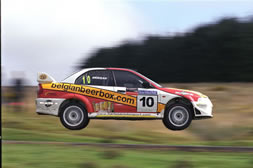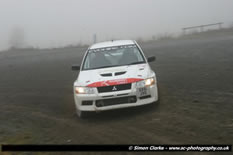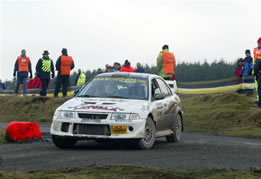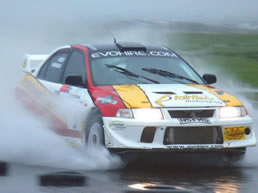 Tyre saving mode !- Mewla Rally Tyre saving mode !- Mewla Rally
The first Car Rally of the season in February is run by Port Talbot Motor Club – The Tour of Epynt, it can be a very variable and exciting tour, not only do you battle the strange road cambers and blind brows but Mother nature throws all she got at you to, from rain, hail, snow and sunshine, fogs and mists.

Rallying in the mist ! Red Kite
Brief History of ' Epynt '
Before one can comment on the unique Car Rallying that takes place on the Epynt ranges, a thought must be given to this wonderful mountain- ‘The Epynt’, as the locals fondly refer to it.
The Epynt is a living mountain were the weather changes in a flash. It can have sunshine on one side and snow on the other all at the same, no two sections of road are the same and scenery is breath taking. It was a homeland to the people that had to leave it, but never forgotten it, and played its part in gaining us the freedom we enjoy today.
Before the outbreak of World War II, Epynt was a thriving Welsh speaking community. The community had been threatened with eviction in 1912- that their lands, and homes, would be taken to train troops. Luckily, this turned out to be just a threat. The community was shaken when in 1939 a young Army Officer appeared on the mountain informing them that he was carrying out a survey on the suitability of their homes and land for a possible requisitioning. Epynt was to become a major military training ground. Most believed that if this happened they would however be able to return after the War. However, it happened, but the Military never relinquished their ownership and no one returned.
Eviction notices were served on 54 families (219 people), forcing them to leave their homes and farms. 40,000 acres were seized. The Drovers Tavern, which took its name from the old drovers who followed the trail with their cattle from South Wales to the markets of London, had pulled it last pint and sheltered its last friends, the landlady, Mrs.Caroline Evans, and her son Jack; they, like many, lost their home and livelihood .
Cilieni School had educated the children of Epynt from 1882. Its teacher, Miss Olwen Davies, was forced to pack the books away for the last time. The Old Methodist Chapel Babell, built in 1859, had sung its last song and the Reverend William Jones said his last prayer within its walls. The foundations of the chapel are still evident as a reminder of its past presence, and gravestones still stand in its grounds.
The Ministry made no attempt at the time to save the old buildings and the heritage of Epynt. Most have now fallen but in recent years, with more thought to conservation, some of farm houses have been restored and the Drovers Tavern is now used by the Military.
There is no doubt that it aided the training of soldiers, being one of the hardest training grounds around. Today one of the Car Rallies, the ‘Harry Flatters’, runs out of a new village built on the Ranges for military training purposes.
The villages at the bottom of The Epynt are also full of history, Llywel on the A40 side between Llandovery and Brecon is the site of a fine Church in Wales Church with nearby Trecastle the home of one of most important families in Welsh History – The Vaughan’s. When you access The Epynt from this side of the mountain from Llywel many are surprised to find a dual carriage in front of them to climb up the mountain.
For six years the ranges were also used for Motorcycle racing and was the largest mountain circuit on mainland Britain.
If you are traveling to Epynt for one of its fine rallies there is plenty to do for the none rally enthusiast, if wish to venture the surrounding area.
On your journey from Llandovery to the ranges you will see on the side of the A40 a Monument, the monument is called the ‘Mail Coach Pillar, and was erected as a reminder to the drivers of the mail coaches on the evil of intoxication. On the 19th December, 1835 Edward Jenkins was driving the mail coach from Gloucester to Carmarthen under the influence of drink. He drove the coach on the wrong side of road at full gallop and met an oncoming cart, he overturned and the coach rolled some 121feet down the bank towards the river breaking into pieces with loss of life.

Jari-Mati Latvala - Early days on Epynt!
Fairfield Motorsport
Telephone : UK 01 656 725000
Overseas 00 44 1656 725000
E-Mail : info@fairfeildmotorsport.com
Ferry travel specialists |
There are unique names on some parts of the Epynt some from it’s ancient history some from it’s early military days and some more modernly named after such people as Noel Edmunds !
We are told that Epynt means ‘path of the horses’. Today as always the main inhabitants of the ranges are the sheep who are said to have grazed and been shepherded there for more than 3,000 years.

Many of the roadways on Epynt have names well known to rally enthusiasts, and some would be less familiar : –
Mabion Way was built by the Mabion Squadron of the Royal Engineers and the road was named after them. New Road, not the newest of the roads built by the Army, the Army called the road Route 61 as it was built by the 61st Squadron Royal Engineers, there is a plaque set in concrete at the bottom of the road commemorating this.
Cilieni Track, runs from Fours Way Bridge to Piccadilly, the stream that flows under Fours Way Bridge is Nant Cilieni.
Burma Road, many of the Soldiers that served as the forgotten Army in Burma trained on the The Epynt, they were the 6th Battalion of the South Wales Borderers.
OP Road, - there were two observations post there observing weapon firing.
Concrete Road, this road was built by the Army in concrete as a cheap substitute to tarmac in 1942 and as never needed resurfacing.
Gardeners Path, Lt. Col. Hamilton Gardener was Commandant of Sennybrige between 1942 and 1944 and Gardeners Path and Gardeners Hill we named after him.
Grahams Way, Colonel ‘Lofty’ Graham was a pervious Commandant of Sennybridge and this was named after him.
Gun Park Road the range roads were not very wide when the ranges were first built and the only place guns could be kept after firing was alongside the road between Llandilo’r Fan and ‘Dixies’. Guns were parked here overnight under guard, hence the name Gun Park Road.
Llewellyn’s Way, Major Llewllyn who was a surveyor in civilian life was the man who first surveyed the range boundary in about 1939/40. The road has since carried his name.
Piccadilly Circus, this was point on the ranges would get so busy that it got named after Piccadilly Circus London were life buzzes 24/7.
Druids, bronze age relics were found in this area, Ynyshir bronze age Cairn & Circle.
Dixie’s, there have always been a lot sheds at Dixie’s since the Army occupation some say that Dixie was a tea boy from Ystradgynlais, some say it a nick name for Dean a Quartermaster who worked there, however which is may be Dixie’s in one the most amour landmarks on The Epynt.
Noel Edmunds – a bend on the new road notorious for accidents and named after the TV Celebrity Noel Edmunds lost control of his car and went off.
Deer’s Leap & Devils almost self explanatory big jumps on the road from Dixies to Llandeilo fan, many cars have landed wrong on these jumps and found their rally is over.
Irish Farm – buildings not far from Merthyr Cynog probably were one of the Irish Regiments served.
German Village, a village built for military training on the stake found in Eastern Europe.
Drovers – the site of the old Drovers public house on the drovers route to London, no restored by the Army.
The Runway
The Wind sock
The Telephone Exchange - from communication posts
On the North side of The Epynt you will find the Town of Llanwrtyd Wells, Llanwrtyd can boast to be the smallest town in Britain and at Llangammarch Wells in the grounds of it’s Church stands a monument to John Penry a Welsh Martyr who fought for the bible to be translated in the native tongue of his fellow people, to the East is the bustling town of Builth Wells, who famous son in history was Sir David Gam - Knighted on the field of battle. On your way to Builth you pass through the village of Cilmeri were a monument stands to a native Prince of Wales - Prince Llewellyn who was killed in battle in 1282, his head was removed and taken for display to London.
 |
